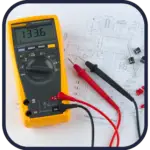Explore the principles of electrostatic voltmeters, their advantages, and applications in high voltage, ESD testing, and more.
Understanding Electrostatic Voltmeters: Principles and Applications
An electrostatic voltmeter is an instrument used to measure electric potential, or voltage, without drawing any current from the circuit being measured. This unique feature makes it ideal for use in sensitive or high-impedance circuits where minimal disruption is desired. In this article, we will explore the principles behind electrostatic voltmeters and discuss some common applications.
Operating Principles of Electrostatic Voltmeters
Electrostatic voltmeters function based on the principle of electrostatic force. The force between two charged plates is directly proportional to the product of the charges on the plates and inversely proportional to the square of the distance between them. Mathematically, this can be expressed as:
F = k × (Q1 × Q2) / r2
Where F is the electrostatic force, Q1 and Q2 are the charges on the plates, r is the distance between the plates, and k is the electrostatic constant.
An electrostatic voltmeter consists of two parallel plates, one fixed and the other movable. The fixed plate is connected to the circuit being measured, while the movable plate is connected to a reference voltage. When a voltage is applied to the fixed plate, an electrostatic force is generated between the plates, causing the movable plate to deflect. This deflection is proportional to the applied voltage and can be measured using a calibrated scale or an electronic sensor.
Advantages of Electrostatic Voltmeters
-
Non-contact measurement: Electrostatic voltmeters do not draw any current from the circuit under test, making them ideal for use in high-impedance or sensitive circuits.
-
Wide frequency range: These instruments can measure both DC and AC voltages, and are capable of measuring signals with frequencies ranging from near-zero to several hundred kilohertz.
-
High accuracy: Electrostatic voltmeters are known for their high accuracy, especially when measuring small voltage differences.
-
Long-term stability: These instruments exhibit excellent long-term stability due to their minimal dependence on temperature or other environmental factors.
Common Applications of Electrostatic Voltmeters
-
High voltage measurements: Electrostatic voltmeters are used to measure high voltages in various industries, such as power distribution, research laboratories, and manufacturing facilities.
-
Electrostatic discharge (ESD) testing: These instruments play a crucial role in ESD testing of sensitive electronic components, ensuring their safety and reliability.
-
Electron beam systems: Electrostatic voltmeters are often used to measure and control the voltage applied to electron beam systems in applications such as electron microscopy and electron beam lithography.
-
Electrostatic field mapping: By using multiple electrostatic voltmeters, it is possible to map the distribution of electric fields in a given area, which can be useful in various research and industrial applications.
In conclusion, electrostatic voltmeters are versatile and accurate instruments for measuring voltage in various applications. Their non-contact measurement principle and wide frequency range make them ideal for use in sensitive



